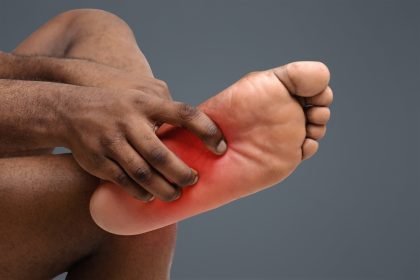Frequent leg and foot cramps might signal underlying health problems requiring medical attention. While occasional cramps are common, persistent episodes warrant investigation and proper treatment. Understanding these warning signs could prevent serious complications and improve quality of life.
Common causes of muscle cramps
Dehydration leads the list of cramp triggers. Without adequate water, muscles lack essential nutrients and electrolytes needed for proper function. Even mild dehydration can trigger painful muscle spasms and affect overall health.
Signs of dehydration include:
- Dark urine color
- Persistent dry mouth
- Unusual fatigue
- Frequent dizziness
- Reduced sweating
- Increased thirst
- Muscle weakness
- Headaches
- Confusion
- Light-headedness
Nutrient deficiencies often trigger muscle spasms. Key minerals affecting muscle function include:
- Potassium for nerve signals and muscle contractions
- Magnesium for muscle relaxation and nerve function
- Calcium for proper muscle response and bone health
- Vitamin D for mineral absorption and muscle strength
- Vitamin B12 for nerve health and muscle coordination
- Iron for oxygen delivery to muscles
- Zinc for muscle repair and recovery
- Sodium for fluid balance
- Phosphorus for energy production
- Selenium for muscle protection
Poor circulation restricts oxygen delivery to muscles, particularly in legs and feet. This often occurs due to:
- Extended periods of sitting or standing
- Tight clothing around legs or waist
- Smoking and tobacco use
- Uncontrolled diabetes
- Cardiovascular disease
- Blood clots in vessels
- Peripheral artery disease
- Obesity and weight issues
- Pregnancy-related changes
- Certain medications
Serious health conditions
Constant cramping may indicate several serious conditions requiring immediate medical attention:
Peripheral artery disease:
- Reduced blood flow to extremities
- Pain during physical activity
- Slow-healing wounds or sores
- Consistently cold feet or legs
- Changes in skin color or texture
- Loss of hair on legs and feet
- Weakened pulse in feet
- Shiny skin appearance
- Leg pain at rest
- Numbness or tingling
Diabetic neuropathy:
- Numbness in hands and feet
- Burning or tingling sensations
- Balance and coordination problems
- Progressive muscle weakness
- Reduced reflexes and sensitivity
- Foot ulcers and infections
- Digestive issues and nausea
- Temperature sensitivity
- Changes in sweating
- Joint pain and stiffness
Kidney disease:
- Changes in urination frequency
- Swelling in ankles and feet
- Persistent fatigue
- Metallic taste in mouth
- Ongoing nausea
- Poor appetite
- Sleep disruption
- Itchy skin
- Mental fog
- Muscle twitches
Prevention strategies
Take these comprehensive steps to reduce cramp frequency:
Hydration habits:
- Drink water consistently throughout day
- Monitor urine color for hydration
- Increase intake during exercise
- Consider electrolyte replacement drinks
- Track daily water consumption
- Pre-hydrate before physical activities
- Adjust intake for climate conditions
- Limit dehydrating beverages
- Eat water-rich foods
- Set hydration reminders
Dietary adjustments:
- Include potassium-rich foods like bananas
- Add magnesium sources such as nuts
- Maintain calcium intake through dairy
- Limit alcohol consumption
- Reduce caffeine intake
- Choose nutrient-dense whole foods
- Consider supplements with medical guidance
- Balance electrolyte intake
- Eat regular balanced meals
- Monitor salt consumption
Physical activity:
- Perform regular stretching routines
- Wear appropriate supportive footwear
- Take frequent walking breaks
- Avoid overexertion during exercise
- Maintain proper posture
- Practice correct exercise form
- Include proper cool-down periods
- Build strength gradually
- Listen to body signals
- Stay active within limits
When to seek help
Contact healthcare providers immediately when experiencing:
Urgent concerns:
- Severe and persistent muscle pain
- Swelling accompanied by cramping
- Unusual redness or warmth
- Significant difficulty walking
- Sudden muscle weakness
- Numbness or tingling sensations
- Notable changes in skin color
- Chest pain or shortness of breath
- Fever with leg pain
- Signs of infection
Ongoing issues:
- Frequent nighttime cramps
- Regular daytime cramping episodes
- Exercise-induced muscle spasms
- Consistently cold extremities
- Persistent unexplained fatigue
- Unexpected weight changes
- Changes in urination patterns
- Sleep disruption from cramps
- Chronic muscle soreness
- Decreased mobility
Treatment approaches
Healthcare providers may recommend various interventions:
Medical interventions:
- Comprehensive blood testing
- Circulation assessments
- Nerve conduction studies
- Medication adjustments
- Physical therapy sessions
- Compression garment use
- Lifestyle modifications
- Dietary counseling
- Exercise programs
- Regular monitoring
Self-care methods:
- Regular stretching routines
- Professional massage therapy
- Heat therapy applications
- Cold therapy treatments
- Leg elevation periods
- Adequate rest breaks
- Activity modifications
- Proper footwear
- Stress management
- Sleep hygiene
Listen to your body
Persistent leg and foot cramps require careful attention and proper medical evaluation. While some causes prove minor, others signal serious health conditions needing immediate treatment. Taking proactive steps to address cramping can prevent complications and improve overall health.
Monitor cramp patterns and accompanying symptoms carefully. Track frequency, duration and potential triggers to help healthcare providers determine underlying causes. Keep a symptom diary to share with medical professionals.
Remember that early intervention often leads to better outcomes. Don’t dismiss constant cramping as normal aging or simple overexertion. Seek professional guidance when cramps interfere with daily activities or sleep patterns. Your body’s warning signs deserve attention and proper care.
This story was created using AI technology.















